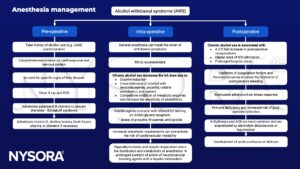Learning objectives
- Recognize signs and symptoms of alcohol withdrawal syndrome and delirium tremens
- Manage and treat alcohol withdrawal syndrome and delirium tremens
Definition and mechanism
- Alcohol withdrawal syndrome (AWS) is a set of symptoms that occur following a reduction in alcohol use after a period of excessive use
- Symptoms can be suppressed by alcohol intake and are more common in the postoperative period
- AWS starts typically after 6-24 hours without alcohol and is most pronounced at 24-36 hours, however, can be delayed for up to 5 days
- AWS results from neurological changes after long-term alcohol use:
- Ethanol binds to postsynaptic GABAA receptors, thereby enhancing their inhibitory effect
- The resulting chronic excitatory suppression leads to an increased brain synthesis of excitatory neurotransmitters such as norepinephrine, 5-hydroxytryptamine, and dopamine
- The brain is flooded with increased levels of excitatory neurotransmitters when the inhibitory effects of ethanol are withdrawn
- Delirium tremens is a rapid onset of confusion due to alcohol withdrawal
- Delirium tremens occurs in 5% of patients experiencing withdrawal
- Mortality rate of delirium tremens is 10% (due to hypotension, dysrhythmias or seizures)
Signs and symptoms
| AWS | Delirium tremens |
|---|---|
| Tremors Nightmares Hallucinations Gastric upset Nausea Vomiting Hyperreflexia Anxiety Agitation Mild confusion Insomnia Autonomic nervous system hyperactivity (tachycardia, Hypertension, cardiac dysrhythmia) | Shaking Shivering Tachycardia Sweating Hallucinations Hyperthermia Nausea Vomiting Seizures Agitation Aggression Tachycardia Hypertension or Hypotension Grand mal seizures |
Medical disorders associated with alcoholism
| CNS | Wernicke–Korsakoff syndrome Peripheral neuropathy Autonomic dysfunction |
| CVS | Cardiomyopathy Heart failure Hypertension Arrhythmias (e.g. AF, SVT, VT) |
| GI | Alcoholic liver disease Pancreatitis Gastritis Oesophageal and bowel carcinoma |
| Metabolic | Hyperlipidemia Obesity Hypoglycemia Hypokalemia Hypomagnesemia Hyperuricemia |
| Hematological | Macrocytosis Thrombocytopenia Leucopenia |
| Musculoskeletal | Myopathy Osteoporosis Osteomalacia |
Treatment
Prophylactic treatment before the onset of AWS symptoms
- Benzodiazepines or clomethiazole
- Oral or enterally applied alcohol administration (0.5 g/kg body weight/day)
- Adjuncts such as alpha2-agonists
Benzodiazepines are the first-line treatment for AWS and delirium tremens
Class Example Duration of action Route of administration Dose
Benzodiazepines Chlordiazepoxide Long p.o.
Prophylaxis: 5-25 mg
Treatment: 50 -100 mg
Lorazepam Short p.o./IV
Prophylaxis: 0.5-2 mg
Treatment: 1-8 mg
Other agents
Diazepam Long p.o./IV
Prophylaxis: 2.5-10 mg
Treatment: 10-40 mg
Clomethiazole p.o.
Prophylaxis: 9-12 capsules in 24h
Haloperidol p.o./IV/IM
Treatment: 0.5-20 mg
Clonidine IV Treatment: 0.1-1 mg bolus/0.1-4 µg/kg/h
- Be aware that the required doses for severe AWS can vary substantially within the first 24h
- Clomethiazole is not advised in critically ill patients due to bronchial secretion and a elevated risk of pneumonia
- Non-benzodiazepine agents should be used in conjunction with benzodiazepines
- Beta-adrenergic blockers and centrally acting alpha-adrenergic agonists (clonidine, dexmedetomidine) achieve symptomatic control but they do not reduce the incidence of delirium or seizures
- Haloperidol (for severe agitation or hallucinations) may increase the risk of seizures
- Consider anticonvulsant agents such as carbamazepine, sodium valproate, and topiramate
General treatment
- Correct metabolic (potassium, magnesium, and thiamine) and hemodynamic derangements
- Correct fluid and blood product deficits
- General supportive care (early nutrition)
- Severe cases will need ICU admission & propofol infusion/dexmedetomidine & possible intubation
- Offer psychosocial support: counseling and detoxification/rehab
Management

Keep in mind
As the severity of withdrawal symptoms can vary greatly, a scale such as the CIWA-Ar is useful for:
- Monitoring the effectiveness of prophylactic treatment or fixed-schedule treatment regimens
- Guiding administration in symptom-triggered treatment regimens
Suggested reading
- Ungur A, L, Neumann T, Borchers F, Spies C: Perioperative Management of Alcohol Withdrawal Syndrome. Visc Med 2020;36:160-166.
- Chapman, Richard & Plaat, Felicity. (2009). Alcohol and anaesthesia. Continuing Education in Anaesthesia, Critical Care & Pain. 9. 10-13.
We would love to hear from you. If you should detect any errors, email us at customerservice@nysora.com








